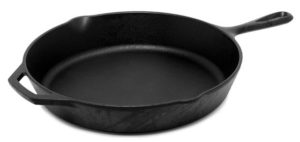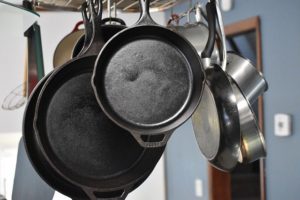 Do you own a cast iron skillet?
Do you own a cast iron skillet?
Do you love it and use it all the time? Or, is it sitting lonely in a cabinet or maybe tucked away with the camping gear in the garage?!
Cast iron skillets can be extremely useful in the kitchen, but can also raise a ton of questions and take some getting used to...
How do you clean it?
What is the deal with "seasoning" it?
What can you cook in it?
Aren’t they really heavy?
We want to help answer your questions and turn any anxiety into a love for this valuable kitchen tool!
What is a cast iron skillet?
 Cast iron has been around since before the 19th century, back when pots and pans were designed to be used over open fire, before the introduction of the kitchen stove. These are the original non-stick pans.
Cast iron has been around since before the 19th century, back when pots and pans were designed to be used over open fire, before the introduction of the kitchen stove. These are the original non-stick pans.
In the 1960's and 70's, as Teflon-coated aluminum cookware hit the market and became the preferred choice in most kitchens, cast iron cookware saw a major decline. But, because of its durability and reliability, cast iron continued to survive and, in the past few years, the use of cast iron cookware has been growing in popularity. Because cast iron cookware is made with one piece of metal, including the handle, it is very versatile, and can even be used both on the stove and in the oven…and even on the grill.
What's so great about a cast iron skillet?
 Not only can this valuable pan caramelize onions, sear steaks, produce delicious fruit crisps, and make a mean pizza crust, but it can also cook fantastic weekend breakfasts, such as a Dutch baby pancake, a frittata or a delicious Huevos Rancheros. (Can you tell we love cast iron skillets?!) And, those are just a few examples!
Not only can this valuable pan caramelize onions, sear steaks, produce delicious fruit crisps, and make a mean pizza crust, but it can also cook fantastic weekend breakfasts, such as a Dutch baby pancake, a frittata or a delicious Huevos Rancheros. (Can you tell we love cast iron skillets?!) And, those are just a few examples!
Cast iron skillets are durable, efficient, and incredibly useful. A few of our favorite features:
- Once they get hot, they stay hot…and they cook evenly. When you begin cooking, it is best to add your oil or butter and let them heat up for a few minutes before you start adding food. That way, you won't experience huge drops in temperature when you add ingredients to the skillet.
- Cast iron skillets can go from the stove to the oven…great for One Pot Sausage and Sweet Potato Enchiladas and One-Pot Chicken and Rice.
 They are so easy to cook with -- giving a browned crispiness to potatoes, chicken or your favorite burger.
They are so easy to cook with -- giving a browned crispiness to potatoes, chicken or your favorite burger.- Panini press – because of their weight, you can use them as a panini press. Just put your sandwich in your skillet, and then use the weight of your cast iron skillet on top to “press down” on the sandwich as it cooks. Try it with the Tropical Pork Cuban Sandwich or the Simple Savory Tuna Melt!
What does it mean to "season" your cast iron skillet?
Even though “seasoning your skillet” sounds complicated, it's really simple. By heating fat in your cast iron skillet over high heat, the fat molecules bond to the pan and transform it into a non-stick surface. That’s what “seasoning” is all about. What is the best way to maintain a seasoned non-stick coating on your cast iron skillet?
Get cooking!
Every time you cook steak, chicken, or other foods with fat, the fat adds another layer to the pan's surface. You can re-season your pan with oil anytime it looks dry or dull, or if it’s been a while since you cooked with it. Some prefer to rub their skillet with oil and place in a 500-degree oven for one hour to add a good season to it, but you can also do this simply by cooking in it.
If you purchase a "pre-seasoned" cast iron skillet, that simply means a thin layer of wax or oil has been applied to the skillet to keep it from rusting while it sits in the store or warehouse. You will season it even more as you cook with it.
How do you clean a cast iron skillet?
- If possible, it is best to clean your skillet while it is still warm.
- After cooking with it, wipe out any bits of food with a paper towel or rag.
- If you have stubborn stuck-on pieces, use a scraper, a scrubber or a brush (with bristles or fibers that are not so rough they will scratch the surface of your pan), or use salt and a rag.
- Water is not the enemy, so feel free to use a little water, and even using a drop of soap will not do major damage. You DO NOT want to soak your cast iron skillet or use harsh detergents, and NEVER place a cast iron skillet in the dishwasher.
- Once clean, dry it immediately.
- Then, use a paper towel and rub the entire skillet, including the bottom and sides, with a neutral oil, such as vegetable or grapeseed oil. (If you don't rub with oil the skillet will begin to look rusty – and the fat acts as a barrier against rust and decay.)
What size of cast iron skillet?
Cast iron skillets come in a variety of sizes, but a 10-inch or 12-inch skillet is ideal for everyday cooking.
Keep in mind, the bigger the skillet the heavier it will be, which can limit how easy it is to maneuver while you cook.
Can a cast iron skillet be used on a glass top stove?
Yes! A cast iron skillet can be used on a glass top stove if you are aware of a few precautions:
- Make sure the skillet fits the size and extends about one inch beyond the outermost rings of the burner under the glass.
- Check the bottom of the skillet - you want it to have a flat, even bottom with no rough spots that can scratch the glass surface.
- When cooking, be sure to lift and move the skillet instead of sliding to avoid scratching the glass stove top.
What about iron leaching into my food?
Using a cast iron skillet can increase the iron content of your food. For those needing to increase their iron content, this can be beneficial. For those at risk of having too much iron in their bodies, this is something to be aware of. How much iron is absorbed by the food depends on several factors including the cooking time, the acidity of the foods, how well-seasoned the pan is and other factors. For anyone who needs to limit their iron content, you can purchase an enameled cast iron skillet, which has a barrier that will keep the iron out of your food.
Now the fun part...what can you cook in a cast iron skillet?
 We have experienced excellent results with SO MANY recipes in a cast iron skillet, and here are some of our favorites:
We have experienced excellent results with SO MANY recipes in a cast iron skillet, and here are some of our favorites:
- Homemade Flatbread Crust
- Fruit Topped Dutch Baby, Chocolate Dutch Baby, or Savory Dutch Baby
- Sweet Potato Frittata
- Cacao Spiced Pork Tenderloin
- Healthi-Fried Chicken Drumsticks
- Whole Roasted Cauliflower
- French Inspired Fish & Fennel Skillet
- Butternut Squash Veggie Bake
- One Pot Chicken with Artichokes and Fennel
- Rosemary Swiss Burgers with Mushroom Sauce
- Sloppy Joe Egg Skillet
- Tuscan Chicken
- Butternut Squash Shakshuka
- Salmon Sheet Pan Fajitas
- and so much more!
Are there things you should NOT cook in a cast iron skillet?
There are a few things you may not want to use your cast iron skillet for, mainly because they are either a nightmare to clean, or they have prominent flavors that will affect the seasoning and taste of other foods cooked in your skillet.
- Scrambled eggs don’t do well in a cast iron skillet…it is best to opt for a non-stick skillet instead.
- Tomato sauce - its high acidity can react with the iron of the skillet and can sometimes result in a metallic flavor.
- Fish – the fish flavor can linger into other dishes, producing undesired results.
NOTE: in our personal experience, we have a very well-seasoned skillet and have used it to prepare tomato sauce and seafood dishes and have not noticed any metallic taste or any “carry-over” taste in other dishes. When you have a well-seasoned skillet, the food is less likely to penetrate the metal to significantly affect the flavor.
Give it a try!
If you have been thinking about purchasing a cast iron skillet, or are considering reviving one you already own, go ahead, give it a try and get cooking! (They also make great gifts!) You may fall in love and end up like us saying "where has this amazing kitchen tool been all our lives?"
Do you have tips and ideas for cast iron skillets you would like to share?
Please let us know!




Great information! My mom always used cast iron skillets! She made the best fried chicken and gravy! I love them but they are too heavy for my arthritic hands to mange 😥
Can you use salt or a green scrub pad to clean rust from the skillet before seasoning it?
Toni – Thank you for asking! You can use fine steel wool to scrub the rust off (I know we say to not use abrasive brushes or scrubbers but you are not worrying about breaking down the seasoning yet!) then proceed to wash it with warm soapy water and a bristle brush, scouring pad or mesh sponge if needed. Then, dry it thoroughly and rub it with oil. This should bring it back to life and then you can start cooking with it! Let us know how it goes – thank you!